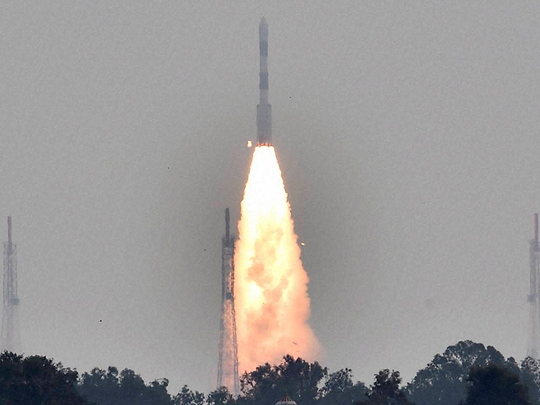
Sriharikota, Andhra Pradesh: India on Monday joined a select group of nations owning a space observatory with the successful launch of ASTROSAT by rocket.
The launch also put into orbit six other foreign satellites.
With the successful launch of ASTROSAT, India gained an entry into the select club of nations having its own space observatory after the US, Japan, Russia and Europe.
At exactly 10am, the 44-metre tall, 320-tonne polar satellite launch vehicle’s XL variant (PSLV-XL) blasted off the first launch pad at the rocket port here, around 80km from Chennai.
The PSLV-XL rocket with seven satellites cumulatively weighing 1,631kg climbed up steadily gathering speed amid cheers from Indian space agency officials and journalists assembled here.
The expendable rocket carried Rs1.8 billion (Dh100 million) ASTROSAT, India’s first dedicated multi-wavelength space observatory that will help in understanding the universe, and six other foreign satellites.
While ASTROSAT with a five year lifespan weighed 1,513kg, the six foreign satellites (four from the US and one each from Indonesia and Canada) together weighed 118kg.
Incidentally, this is the first time that an Indian rocket launched satellites from the US.
According to an official of Antrix Corporation — the commercial arm of India Space Research Organisation (Isro) — a deal has been signed to put into orbit nine American nano/micro satellites by the end of 2016.
While four US satellites have been put into orbit on Monday, the remaining five would also piggyback on a bigger satellite later.
At the mission control room, space scientists at Indian Space Research Organisation (Isro) were glued to their computer screens watching the rocket escaping the earth’s gravitational pull.
Just over 22 minutes into the flight, the rocket slug ASTROSAT at an altitude of 650km above the earth.
Soon after, six other satellites were put into orbit and the whole mission ended in just over 25 minutes.
For the third time a PSLV rocket has launched seven satellites in a single mission. In 2008, Isro had launched 10 satellites in one go, including India’s Cartosate-2A satellite.
Immediately on the successfully ejection, scientists at the mission control centre were visibly relieved and started clapping happily. In the process India crossed the half century milestone when it its rocket injected the six foreign satellites successfully into their intended orbit.
Till date, India has launched 45 foreign satellites for a fee.
Isro chairman A.S. Kiran Kumar described it as an “eventful day” and congratulated the entire Isro team.
P. Kunhi Krishnan, director, Satish Dhawan Space Centre, said: “PSLV’s success is continuous. Today it injected seven satellites in
precise orbit.”
However, it will not be right to call ASTROSAT as India’s ‘Hubble’. The Hubble owned and launched by the US in 1990 is 10 times heavier than the ASTROSAT and is said to cost $2.5 billion.
While the Hubble space telescope is still working now, India’s ASTROSAT’s lifespan is five years.
ASTROSAT, will observe the universe through optical, ultraviolet, low and high energy X-ray components of the electromagnetic spectrum, whereas most other scientific satellites are capable of observing through a narrow wavelength band.
The five payloads/instruments of ASTROSAT are selected to facilitate deeper insight into the various astrophysical processes occurring in the various types of astronomical objects constituting our universe, Isro said.
The payloads are developed by different institutions-domestic and foreign- on their own or collaborating with Isro.
Of the five payloads, the Ultraviolet Imaging Telescope (UVIT) is jointly developed by Indian Institute of Astrophysics (IIA), Bengaluru and Inter University Centre for Astronomy and Astrophysics (IUCAA) at Pune in collaboration with Canadian Space Agency and Isro.
This instrument can observe the sky in the visible near ultraviolet and far ultraviolet regions of the electromagnetic spectrum.
The second payload Large Area X-ray Proportional Counter (LAXPC) is developed by Tata Institute for Fundamental Research TIFR), Mumbai and Raman Research Institute (RRI), Bengaluru.
The third payload Soft X-ray Telescope (SXT) is developed by TIFR in collaboration with the University of Leicester, UK and Isro.
The fourth payload Cadmium Zinc Telluride Imager (CZTI) was developed by TIFR and IUCAA in collaboration with Isro.
And the fifth one Scanning Sky Monitor (SSM) was jointly developed by Isro Satellite Centre at Bengaluru and IUCAA.
The Indonesian 76kg LAPAN-A2 is a micro-satellite from the National Institute of Aeronautics and Space, meant for providing maritime surveillance using automatic identification system (AIS), supporting Indonesian radio amateur communities for disaster mitigation and carrying out earth surveillance using video and digital camera.
The 14kg NLS-14 (Ev9) of Space Flight Laboratory, University of Toronto Institute for Advanced Studies, is also a maritime monitoring Canadian nano satellite using the next generation AIS.
The remaining four LEMUR nano satellites from Spire Global Inc, San Francisco, US, are non-visual remote sensing satellites, focusing primarily on global maritime intelligence through vessel tracking via AIS and high-fidelity weather forecasting using GPS radio occultation technology, the Isro said.












